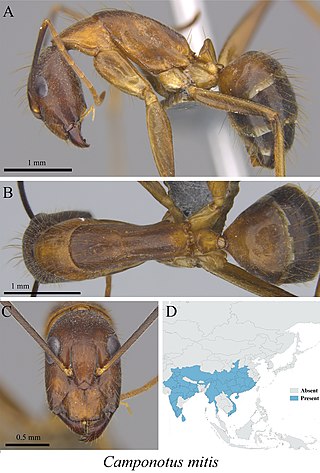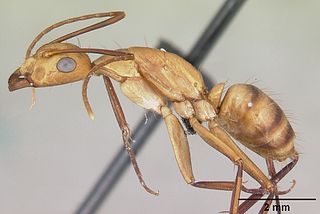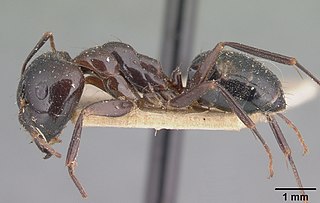
Carpenter ants are large ants indigenous to many forested parts of the world.

Camponotus atriceps, previously referred as C. abdominalis, is a species of carpenter ant, endemic to the Americas.

Camponotus japonicus, commonly known as the Japanese carpenter ant, is a species of ant native to eastern Asia. It is black, and one of the largest ants. A nest has about ten to thousands of individuals, and it can be a pest when it enters households or protects aphids. There are several subspecies of this ant in different areas of Asia, with the largest of the species being located in northern China.
Camponotus irritans is a species of carpenter ant. It is found in many Asian and Oceanian countries.

Camponotus maculatus is a species of carpenter ant.

Camponotus mitis is a species of carpenter ant. It is found from India, Sri Lanka, and China.
Camponotus ominosus is a species of carpenter ant. It is found from Sri Lanka.

Camponotus rufoglaucus is a species of carpenter ant. It is found from many Afrotropical, Indo-Australian, Oriental, Palaearctic regional countries.
Camponotus reticulatus is a species of carpenter ant. It is found from many Afrotropical, Indo-Australian, Oriental, Palaearctic regional countries and in Singapore.
Camponotus thraso is a species of carpenter ant. The type species is found from Sri Lanka.

Camponotus variegatus is a species of carpenter ant.

The Namib Desert dune ant, is a large ant species distinguished by white and black symmetrical stripes and markings on its hairy abdomen. It has an average mass of 45 milligrams (0.0016 oz). It is classified within the carpenter ant genus, a large group of more than 1,000 known species, many of which are associated with forested habitats in America and elsewhere. However C. detritus inhabits the hot dry dunes of the hyper-arid central Namib Desert in Southern Africa. Like many other ant species, it obtains its food and moisture by climbing the stalks of plants and drinking honeydew from scale insects, which themselves feed on shrubs and other perennial plants. It will also feed on dead insects. The nests of this species, located amongst perennial plant roots, are systems of tunnels and chambers between 100–400 millimetres (3.9–15.7 in) deep. Nests can reach temperatures of 35 °C (95 °F) in summer, though they are much cooler in winter, typically 20–23 °C (68–73 °F). Nests are often lined with detritus - hence the binomial Latin name of the species. Each colony contains a single queen.

Camponotus dumetorum is a species of carpenter ant native to North America. They are related to other species from the subgenus Tanaemyrmex in western North America such as C. semitestaceus and C. vicinus. C. dumetorum are primarily nocturnal and form nests underground. Like other select ant species native to California, their populations have been displaced with the introduction of Argentine ants.

Camponotus buddhae is a species of carpenter ant found in India, Iran, Kyrgyzstan, Russia, Turkey, and Turkmenistan.
Camponotus coriolanus is a species of carpenter ant found in Brazil.
Camponotus divergens is a species of carpenter ant found in Brazil.
Camponotus ephippium is a species of carpenter ant found in Australia. It has two subspecies, C. ephippium ephippium and C. ephippium narses.
Camponotus fayfaensis is a species of carpenter ant found in coastal regions of Yemen, Saudi Arabia, and the UAE.

Camponotus gibber is a species of carpenter ant found in Madagascar.
Camponotus holzi is a species of carpenter ant found in Ecuador.










